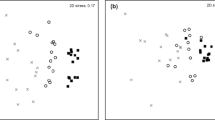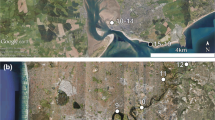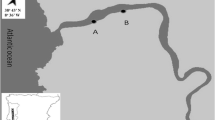Abstract
A small-scale laboratory study was conducted to assess the capability of nematode species collected at an intertidal mudflat to migrate laterally into defaunated sediment by using an experimental design that excluded hydrodynamic influences. The colonisation of native mud, non-native sand and two types of non-native mud-sand mixture was monitored over a period of 2 months. Results revealed that the composition of source and colonist communities differed significantly between treatments and over time. Within the first 2 weeks of the experiment, dominance patterns in the control sediments were most similar to the sand treatment, indicating that the majority of species were able to migrate easily into non-native sandy sediment. Over the course of the experiment, colonist communities in the muddy sediments became more similar to the control microcosms, whereas the structure of the sand assemblage became increasingly dissimilar to that of the source community. The temporal patterns observed might be related to factors associated with sediment granulometry, such as the availability of appropriate food sources. The outcome of this study demonstrated that the colonisation of defaunated sediment via lateral interstitial migration is a directed, species-specific process that can lead to the establishment of colonist communities that are significantly different from source communities.







Similar content being viewed by others
References
Andrassy I (1954) Die Rauminhalts- und Gewichtsbestimmung der Fadenwürmer (Nematoden). Acta Zool 2:1–14
Armonies W (1988) Active emergence of meiofauna from intertidal sediment. Mar Ecol Prog Ser 43:151–159
Armonies W (1994) Drifting meio- and macrobenthic invertebrates on tidal flats in Königshafen: a review. Helgol Wiss Meeresunters 48:299–320
Bell S (1988) Experimental techniques. In: Higgins RP, Thiel H (eds) Introduction to the study of meiofauna, Smithsonian Institution Press, Washington D.C., pp 169–180
Chandler TG, Fleeger JW (1983) Meiofaunal colonization of azoic estuarine sediment in Louisiana: mechanisms of dispersal. J Exp Mar Biol Ecol 69:175–188
Christie H, Berge JA (1995) In situ experiments on recolonisation of intertidal mudflat fauna to sediment contaminated with different concentrations of oil. Sarsia 80:175–185
Clarke KR, Gorley RN (2001) PRIMER v.5. User manual. PRIMER-E, Plymouth
Clarke KR, Warwick RM (1994) Change in marine communities: an approach to statistical analysis and interpretation. Natural Environment Research Council, Plymouth
Colangelo M, Ceccerelli VU (1994) Meiofaunal recolonisation of azoic sediment in a Po Delta Lagoon (Sacca di Goro). Boll Zool 61:335–342
Commito JA, Tita G (2002) Differential dispersal rates in an intertidal meiofauna assemblage. J Exp Mar Biol Ecol 268:237–256
Coull BC, Palmer MA (1984) Field experimentation in meiofaunal ecology. Hydrobiologia 118:1–19
Fegley SR (1987) Experimental variation of near-bottom current speeds and its effect on depth distribution of sand-living meiofauna. Mar Biol 95:183–191
Giere O (1993) Meiobenthology—the microscopic fauna in aquatic sediments. Springer, Berlin Heidelberg New York
Günther C-P (1992) Dispersal of intertidal invertebrates: a strategy to react to disturbances of different scales? Neth J Sea Res 30:45–56
Hagerman, GM, Rieger RM (1981) Dispersal of benthic meiofauna by wave and current action in Bogue Sound, North Carolina, USA. Mar Ecol 2:245–270
Hockin, DC (1982) The effects of sediment particle diameter upon the meiobenthic copepod community of an intertidal beach: a field and a laboratory experiment. J Anim Ecol 5:555–572
Jones SE, Jago CF (1993) In situ assessment of modification of sediment properties by burrowing invertebrates. Mar Biol 115:133–142
Kern JC (1990) Active and passive aspects of meiobenthic copepod dispersal at two sites near Mustang Island, Texas. Mar Ecol Prog Ser 60:211–223
Levin LA, Talley D, Thayer G (1996) Succession of macrobenthos in a created salt marsh. Mar Ecol Prog Ser 141:67–82
Palmer MA (1988) Dispersal of marine meiofauna: a review and conceptual model explaining passive transport and active emergence with implications for recruitment. Mar Ecol Prog Ser 48:81–91
Palmer MA, Gust G (1985) Dispersal of meiofauna in a turbulent tidal creek. J Mar Res 43:179–210
Pearson TH, Stanley SO (1979) Comparative measurement of the redox potential of marine sediments as a rapid means of assessing the effect of organic pollution. Mar Biol 53:371–379
Romeyn K, Leiseboer J (1989) Effecten van verhoogde sediment depositie op nematoden uit het Eems-Dollard estuarium. Vakgroep Mariene Zoologie, Rijksuniversiteit Groningen, Netherlands
Rosenberg R, Nilsson HC, Diaz RJ (2001) Response of benthic fauna and changing sediment redox profiles over a hypoxic gradient. Estuarine Coastal Shelf Sci 53:343–350
Sacco JN, Seneca ED, Wentworth TR (1994) Infaunal community development of artificially established salt marshes in North Carolina. Estuaries 17:489–500
Sandnes J, Forbes T, Hansen R, Sandnes B, Rygg B (2000) Bioturbation and irrigation in natural sediments, described by animal-community parameters. Mar Ecol Prog Ser 197:169–179
Schratzberger M, Warwick RM (1999). Effects of various types of disturbances on nematode communities: an experimental approach. Mar Ecol Prog Ser 181:227–236
Schratzberger M, Rees HL, Boyd SE (2000a) Effects of simulated deposition of dredged material on structure of nematode assemblages—the role of burial. Mar Biol 136:519–530
Schratzberger M, Rees HL, Boyd SE (2000b) Effects of simulated deposition of dredged material on structure of nematode assemblages—the role of contamination. Mar Biol 137:613–622
Schratzberger M, Wall CM, Reynolds WJ, Reed J, Waldock MJ (2002). Effects of paint-derived tributyltin (TBT) on structure of estuarine nematode assemblages in experimental microcosms. J Exp Mar Biol Ecol 272:217–235
Snelgrove PVR, Butman CA (1994) Animal-sediment relationships revisited: cause versus effect. Ocean Mar Biol Annu Rev 32:111–177
Somerfield PJ, Warwick RM (1996) Meiofauna in marine pollution monitoring programmes. A laboratory manual. Ministry of Agriculture, Fisheries and Food, Directorate of Fisheries Research, Lowestoft, UK
Thistle D (1981) Natural physical disturbacnces and communities of marine soft bottoms. Mar Ecol Prog Ser 6:223–228
Vanaverbeke J, Steyaert M, Vanreusel A, Vincx M (2003) Nematode biomass spectra as descriptors of functional changes to human and natural impact. Mar Ecol Prog Ser 249:157–170
Acknowledgements
We thank members of the Centre for Environment, Fisheries and Aquaculture Science for practical assistance, and especially Clare Morris and Caroline Limpenny for the analysis of sediment samples. David Pearce made valuable suggestions concerning the experimental set-up and Melanie Austen made constructive comments on the manuscript. The work was supported by the Department for Environment, Food and Rural Affairs (project AE0231).
Author information
Authors and Affiliations
Corresponding author
Additional information
Communicated by J.P. Thorpe, Port Erin
Rights and permissions
About this article
Cite this article
Schratzberger, M., Whomersley, P., Warr, K. et al. Colonisation of various types of sediment by estuarine nematodes via lateral infaunal migration: a laboratory study. Marine Biology 145, 69–78 (2004). https://doi.org/10.1007/s00227-004-1302-1
Received:
Accepted:
Published:
Issue Date:
DOI: https://doi.org/10.1007/s00227-004-1302-1




